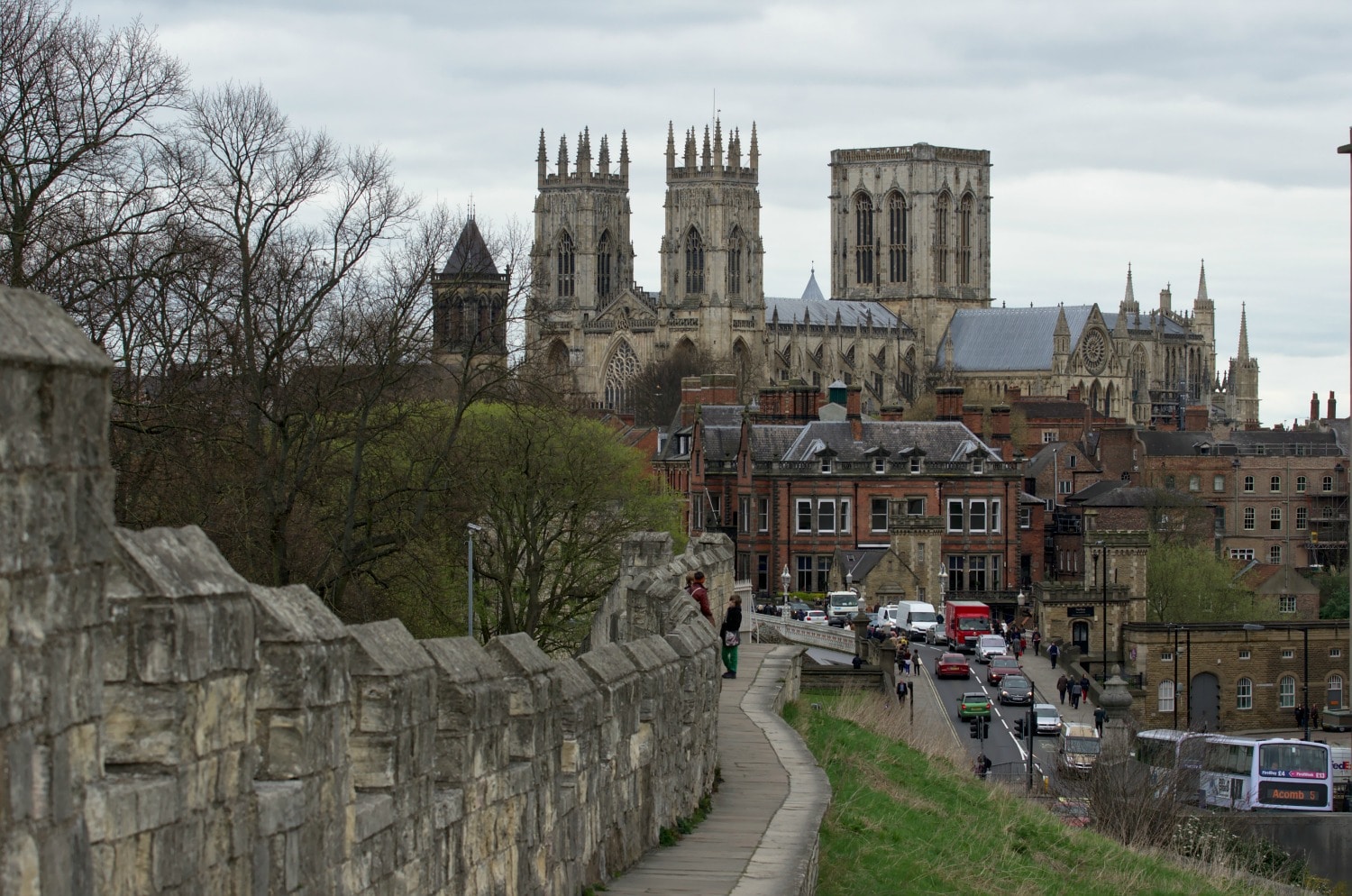The Doomstone. That’s its name, and it’s the best relic I’ve ever seen. Aside from sounding like something Indiana Jones might off a few Nazis for, it depicts a typical day in Hell: fiends, demons and a cauldron full of the damned — Bon Appetit!
A picture is worth 1000 words, and in the Dark Ages, a time when saving souls was first and foremost, churches were not above “scaring the Hell out” of their congregations to keep them from sinning. And I’m standing in one of the churches that set that standard: York Minster.
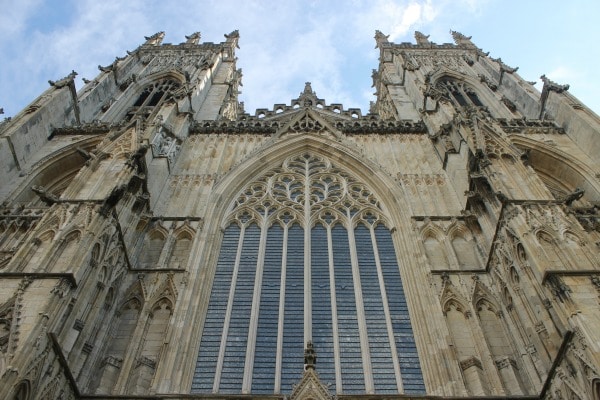
I ♥ Old York
One of the largest cathedrals, rising 235 feet above the city skyline, the Minster, at a mere 545 years old, is amazingly one of the youngest additions to it. Few cities embrace the ancient like York. Medieval walls enclose the town, and my hotel sits beside an old Roman road. When the Romans founded the city (then called Eboracum) on the River Ouse in 71 AD, they knew it was a big deal; control it and you control the north of England to the Scottish border. The Anglo-Saxons (Eoforwick) after them knew it, and then on down to the Vikings (Jórvík), the English (Eoforic), the Normans (Everwic), and again the English (York). They all knew it and with each new occupant, a new layer of York was laid.
You can see some of those layers in the cathedral itself. Work in the crypts revealed the old Roman trooping ground; in 1969, a 31-foot-tall column from the Roman headquarters was found by the church entrance and is now standing outside opposite a statue of Constantine the Great, one of three Roman emperors to make York the effective capital of the Roman Empire. About midway down the nave is the Kings’ Screen, a masterpiece of medieval statuary counting all the kings of England from William the Conqueror to Henry VI. So, yes, York is in fact all about “layers.” Fifteen feet of ruin and rubble, invasions and intrigue, civil wars and sieges, plagues and plots all lay between Eboracum and modern-day York. When the Mail Coach Inn burned down in 1929, it was discovered that it was over the old Roman baths, and so it reopened as “The Roman Bath.” The basement is now a museum. Today, excavations must be carried out before anything new is built should there be a Roman this, or a Saxon that, or, you know, bodies. Five million of them were buried around the city, many of them from the War of the Roses, wherein York was a principal player (alas, it lost).
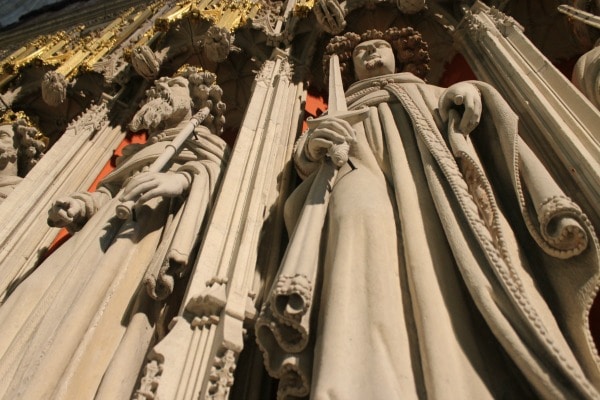
YAAARH!
But amazingly, all of this is playing second fiddle. From the mead on the pub shelves to the cute horned helmets on the kids and the battle axes on the sales racks, if York has a favorite chapter in its history, it’s the Vikings. There’s even a yearly festival called Jolablot, which celebrates all things Nordic.
The extent of York’s historical footprint is mind boggling. For about 100 years it was capital of the Danelaw, a Norse kingdom called Jórvík (“Yor-vik”). In 1978, routine excavation uncovered a whole Viking Age neighborhood, and it proved that the notion of the Vikings being barbarians was just a bit “off.” True, it was a barbaric age, but the Vikings were not barbaric. No savage made the exquisite gold and silverwork displayed at the Yorkshire Museum; and that archeological site? It’s now the floor of the JORVIK Viking Centre.
The city has pulled out all the stops with this one. Clearly the Centre’s showcase is a ride through an animatronic display of a typical day in Jórvík, circa 900 AD, including everything from workaday farmers to Arabian traders. The language is Old Norse, the clothing perfectly reproduced, and the demythification of the “rabid barbarians” utterly complete. To a point anyway — on display also are two-handed broadswords that could take down a charging rhino; the softer side of Vikings only goes so far I guess.
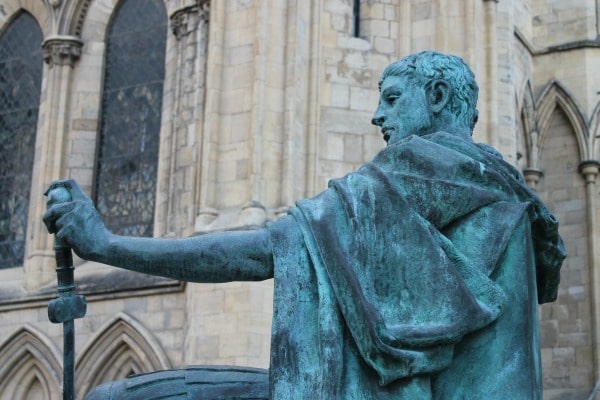
Sweet Spot
And this Viking legacy lives on, particularly in York’s squiggly street grid. I learned that whenever a name ended in “bar” or “gate,” it was Norse for “gatehouse” and “street.” But as I meandered those streets, it dawned on me that for all the contributions made by the Vikings, the Normans and the Saxons, it was actually the Aztecs that had made the most important one.
Stick with me here. Back in the day, say, 1857, refusing military service meant signing off on any career of gravitas. It meant that Henry Rowntree, a Quaker, had to get creative. Enter that ever so popular Mexican import, cocoa.
Jump to the 1890’s and H.I. Rowntree & Co. has made York the sweetest place in Britain; and it still is. Candy stores practically drench York’s streets, each celebrating England’s sweet tooth. Rowntree brainwaves not only include Kit-Kat but also Fruit Pastilles, the godfather of the gummy bear. Other York confectioners, and their creations, soon appeared; Terry’s famous chocolate orange is a particularly sparking gem in York’s candy crown.
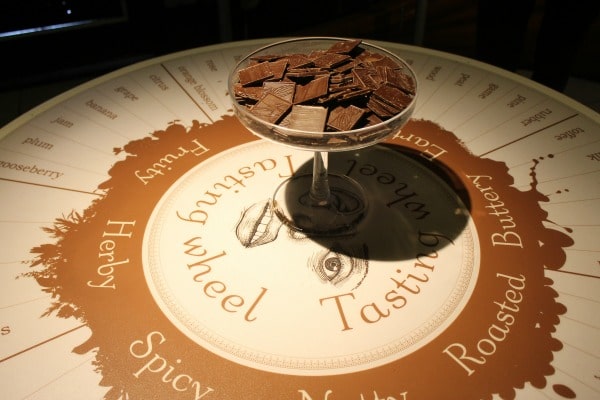
Shades of Yesteryear
Come twilight, the city falls quiet. Fast. My first night was spent laughing up a storm at the York Theatre Royal, where the pantomime is among the best in the UK. But on the second, it was just me and the ghosts. At least, I hoped so. For my guide’s sake.
Seeing dead people is big business in York, the UK’s self-proclaimed “most haunted city.” Ghost tours are a must-do, and the tales are numerous. An entire garrison of phantasmal Roman soldiers nearly trampled Henry Martindale back in 1953. That incident inspired the York Brewery (also haunted) to create Centurion’s Ghost Ale (and it’s a good tipple, too). There’s a naval officer in the Minster, a lady in black in the Ye Olde Starre Inne, and a house at 1-35 Stonegate St. that purportedly has 14 spirits a-haunting.
Alas, I was not as “un-lucky” as Martindale; but I did get a gleefully ghoulish swing through town. In afterthought, daring the restless dead would be a fool’s game for me. After all, I’m a disbeliever and would probably be the first to get tossed into that boiling cauldron.
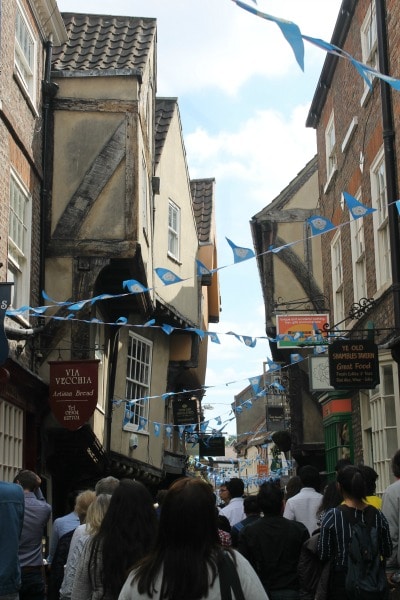
The country and city dialing codes for York are 44, then 1904.
Where to Stay:
The Grange Hotel — Looking like an English country manor right down to the ivy-covered walls, the Grange is like walking into a Jane Austen novel with WiFi and high thread-counts. Four blocks from the city walls and the Bootham Bar and close to the Yorkshire Museum, the York Theatre Royal and York Art Gallery, don’t miss taking a scenic Dame Judi Dench walk along the River Ouse. She’s a proud Yorker. And the Grange’s breakfasts and daily high tea rock, too. 1 Clifton, York YO30 6AA, +44 (0) 1904 644744, grangehotel.co.uk
The Grand Hotel & Spa — Yorkshire’s only five-star hotel, the Grand is conveniently close to the train station. Housed in the iconic former headquarters of the North Eastern Railway Company, the hotel revives the glory of traveling to the north of England. A treat, along with the spas, whisky bar, and suites that swaddle you into oblivion, is to have a traditional English afternoon tea. But watch out! In these parts, “tea” is not light fare, but a full meal. Station Rise, York, North Yorkshire, YO1 6GD; (+0) 1904 891662; thegrandyork.co.uk
The Golden Fleece — It has only four rooms, but for ghost hunters, there’s no better place to stay. In a city known for its hauntings, the Golden Fleece heralds itself as York’s most-haunted property. The rooms themselves, gussied up in period decor, go a long way with the eerie ambience, and the downstairs pub is top of the line. Not far away is York’s shortest street, Whip-Ma-Whop-Ma-Gate. Not making that up. 16 Pavement, York, North Yorkshire, YO1 9UP; (+0) 1904 625171; thegoldenfleeceyork.co.uk
Where to Eat & Drink:
Guy Fawkes Inn — Born in the building that is now a pub in his name, Guido “Guy” Fawkes was a key participant in the Gunpowder Plot of 1605, venturing from York to London with the intent of blowing up Parliament. Of course, he was caught, tortured, and executed, but the famous incident spawned “Guy Fawkes Night” in the UK (November 5), with bonfires and fireworks. City Centre, 25 High Petergate, York, North Yorkshire YO1 7HP; (+0) 1904 623716; guyfawkesinnyork.com
House of Trembling Madness — Now that’s a name. A medieval wattle-and-daub drinking hall with over 600 ales (locally sourced) at the ready. Parts of the property are over 800 years old. Beer lovers should check out the store on the lower level. 48 Stonegate, York, North Yorkshire, YO1 8AS; (+0) 1904 640009; tremblingmadness.co.uk
The Lion & Lamb Inn — Located just inside the city walls near the Bootham Bar, the Lamb & Lion takes “charm” seriously while maintaining a welcoming informality. Sit in the back for the best experience but mind the time; pubs here regularly run out of food, so dinner is often an early event. City Centre, 2-4 High Petergate, York, North Yorkshire YO1 7EH; (+0) 1904 654112; lambandlioninnyork.com
Old White Swan — A traditional pub among a collection of adjoining buildings dating to the 16th century, the Old White Swan is known for 1) its ale selection, and 2) the ghost. 80 Goodramgate, York, North Yorkshire, YO1 7LF;l (+0) 1904 540911; nicholsonspubs.co.uk
York Brewery — Opened in 1996 in the Last Drop Inn, the brewery quickly became a York point of pride. Their handcrafted ales are enjoyed all over the country, but there is nothing like getting one from the source. 12 Toft Green, York, YO1 6JT; (+0) 1904 621162; york-brewery.co.uk
What to See & Do:
Walking the Walls — Nothing in York opens before 10 am, so if you’re an early bird like me, the medieval walls are a wonderful way to see the city. Almost entirely intact, they are punctuated by six “bars”- Bootham Bar, Monk Bar, Walmgate Bar, Micklegate Bar, Fishergate Bar, and Victoria Bar (“bar” is a Yorkish term for “gatehouse,” and “gate” a byword for “street”). These entry points were intrinsic to the city’s defense, but today they serve as mini-museums.
The Shambles — The architecture of this medieval street in the heart of York, voted “Most Picturesque in Britain” by Google Street View Awards, has not changed since the 1400s. Lined with boutiques and shops, a sharp-eyed JK Rowling took a stroll and must have been inspired. Harry Potter fans will note similarities between it and Diagon Alley and there is even a Potter-themed emporium, The Store That Must Not Be Named. Historyofyork.org.uk and insideyork.co.uk
Ghost Tours — I took Trevor’s Roney’s Ghost Walk Experience but there are four others and you can just show up and join (for around £20). Led by professional actors in period dress, it’s a rollicking rip through York’s most infamous otherworldly sites, with a bit of history and trivia thrown in for color. Starting at various times and places, and with different routes, you never run into another group.
York Minster — It’s big, it’s Gothic, and it can swallow up a morning, easy. An amalgamation of different eras, the simplest way to do the Minster is to start at one end and slowly work your way to the other, keeping in mind the crypts and central tower are also available for viewing. In the crypts you’ll find the “Doomstone” and also the tomb of St. William. Church House, Ogleforth, York, YO1 7JN; +44 (0) 1904 557200; yorkminster.org
York Castle Museum — Clear across town from the Minster is Clifford’s Tower, the sole remnant of York’s medieval castle. Perched high on a hill, it overlooks three buildings, two of which are also part of it. Inside, whole sections reproduce York’s historical streets, from the Victorian Age to the 1960s, populated by actors playing shopkeepers and residents. As one building was a prison, a tour about York’s rather harsh penal history is also on offer. Eye of York, York, YO1 9RY; (+0) 1904 687687; yorkcastlemuseum.org.uk
Jolablot / JORVIK Viking Festival — All Viking communities celebrated Jolablot to welcome in the Spring and signal the end to winter’s worst. As Rio de Janeiro has Carnaval, and New Orleans and Sydney Mardi Gras to call their own, so York has Jolablot. Held every February, expect strongman contests, historical recreations, even a “Best Beard” competition, among the other manly goings-on. jorvikvikingfestival.co.uk/about/history/
JORVIK Viking Centre — Sitting on top of an archeological dig that revealed York’s Viking heritage, the Centre went one step further by installing an amusement ride through a recreated Jórvík, that brings 40,000 archeological finds to life. They even have a Viking sock, the only one ever found. Coppergate Shopping Centre, 19 Coppergate, York YO1 9WT; (+0) 1904 615505; jorvikvikingcentre.co.uk
York’s Chocolate Story — Chocolate already had a long history by the time York got in the game, and this quick, fully-guided jaunt takes you from the original drink the Aztecs favored (bitter), to when it became “solid” (still bitter), to the sweeter treat we know and love today. At the end you can make your own candy. King’s Square, York, YO1 7LD; (+0) 1904 527765; yorkschocolatestory.com
Yorkshire Museum — Built on the extensive ruins of St. Mary’s Abbey, the first thing you’ll notice are the rectangular stone planters in the gardens. Only they aren’t planters; they’re repurposed Roman sarcophagi. The Romans and Vikings take pride of place here, including the mysterious Ninth Legion, a Roman battalion that supposedly vanished somewhere in the British north. Museum Gardens, Museum St, York YO1 7FR; +44 (0) 1904 687687; yorkshiremuseum.org.uk
York Theatre Royal — Unlike nearby Manchester or Leeds, York isn’t known for its nightlife. But the York Theatre Royal, housed in a grand, Gothic building, is an excellent alternative. The specialty here is pantomime, sometimes with genders inverted, and the audience is encouraged to participate with the actors onstage, Rocky Horror Picture Show style. I caught “Robin Hood and the Arrow of Destiny,” where the “man” of the hour was none other than Maid Marian. Go figure! St Leonard’s Place, York, YO1 7HD; (+0) 1904 623568; yorktheatreroyal.co.uk

